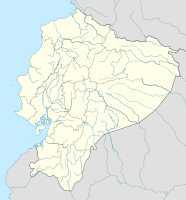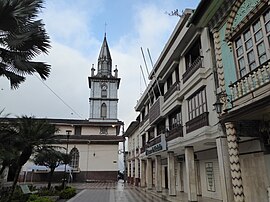Zaruma
| Zaruma | ||
|---|---|---|
|
Coordinates: 3 ° 42 ′ S , 79 ° 37 ′ W Zaruma on the map of Ecuador
|
||
| Basic data | ||
| Country | Ecuador | |
| province | El Oro | |
| City foundation | 1549 | |
| Residents | 9631 (2001) | |
| - in the metropolitan area | 23,300 | |
| Detailed data | ||
| surface | Canton: 643.5 | |
| height | 1200 m | |
| Time zone | UTC -5 | |
| Website | ||
| View of Zaruma | ||
| Sculpture of a gold digger at work in the mine | ||
| Central old town with church | ||
Zaruma is a small gold mining town, which is located at an altitude of approx. 1,200 m in the uneven terrain of the Vizcaya Cordillera , a western foothill of the Andes in southern Ecuador . It is the capital of the canton of the same name in the southeast of the province of El Oro . The city of Zaruma has around 9,600 inhabitants, and a further 13,500 people live in the nine rural parishes of the associated canton.
history
The area of Zaruma was originally inhabited by Kañaris . The first Spanish conquistadors reached the area between 1536 and 1539. In 1539 the exploitation of the Mina del Sexmo gold mine began . The place Zaruma was officially founded in 1549 by Alonso de Mercadillo , who is also known as the founder of Lojas and other places in the south of today's Ecuador. Gold mining in Zaruma reached its first peak between the end of the 16th and mid-17th centuries. The workforce was mainly members of the Quichua ethnic groups and slaves abducted from Africa. The gold from Zaruma became important for the economy of the Real Audiencia de Quito . In 1593 Zaruma was elevated to a villa by King Philip II of Spain under the name of San Antonio del Cerro de Oro de Zaruma (Spanish: Cerro de Oro = "Goldberg") . After 1630 and until the middle of the 18th century there was a crisis in the mining of Zaruma, mainly due to a lack of labor. The importance and population of Zaruma decreased significantly during this time. In 1820 the place gained independence from Spain; In 1824 Zaruma was raised to the capital of a canton in the province of Loja . On November 29, 1882, the founding of the province of El Oro ("The Gold") was proclaimed in Zaruma, the capital of which Zaruma remained until 1884, when it was replaced on the occasion of the official constitution of the province of Machala .
Mining has been intensified again since the 1870s, with foreign capital flowing into the mines, which were operated from 1880 to 1896 by the mainly English Great Zaruma Gold Mining . In 1896 the mines came into the possession of the US South American Development Company , which they exploited until 1950. Due to the now increased mining, the population of Zaruma increased again through immigration. The infrastructure was gradually improved: in 1912 construction began on the church, which is now in the center, since 1921 there was an electricity station, in 1929 the supply of drinking water to the population began, and in 1949 the hospital was opened.
During this time, some parishes belonging to the canton of Zaruma, also mining areas, were spun off and elevated to their own cantons, namely Piñas (1940), Portovelo (1980), Atahualpa (1984), Marcabelí (1986) and Balsas (1987).
Zaruma today
Even today gold and silver are mined in the mines, which can be found mainly in the neighboring, lower-lying Portovelo . In addition to some modern and larger mines - u. a. from BIRA, SA, which also operates a visitor mine in the old tunnel of the Mina del Sexmo - there are numerous private small mines in which extraction is carried out under sometimes precarious conditions.
Zaruma is known as a winding small town, the core of which is an ensemble of well-preserved colonial and 19th-century secular and church buildings made of wood. The old town has been an Ecuadorian cultural heritage since 1990. Important archaeological sites can be found in the village of Huertas, which belongs to the canton of Zaruma. The surrounding mountains offer numerous viewpoints of the city and its surroundings.
In addition to mining, livestock, agriculture, trade and tourism are the most important industries. Smaller factories produce u. a. Textiles. The coffee from Zaruma is marketed in Ecuador as "the best in the world".
On February 24, 2016, Zaruma was placed on the tentative list for World Heritage in Ecuador .
Web links
- Zarumas Tourism Portal (Spanish)
Individual evidence
- ↑ Unless otherwise stated, the information given here comes from the Historia del Cantón page ( Memento of the original from October 4, 2008 in the Internet Archive ) Info: The archive link was automatically inserted and has not yet been checked. Please check the original and archive link according to the instructions and then remove this notice. and their sub-pages on the website of the city administration.
- ↑ Page no longer available , search in web archives: Minería Histórica on the website of the city administration
- ↑ Zaruma ciudad minera on the UNESCO tentative list (English)



